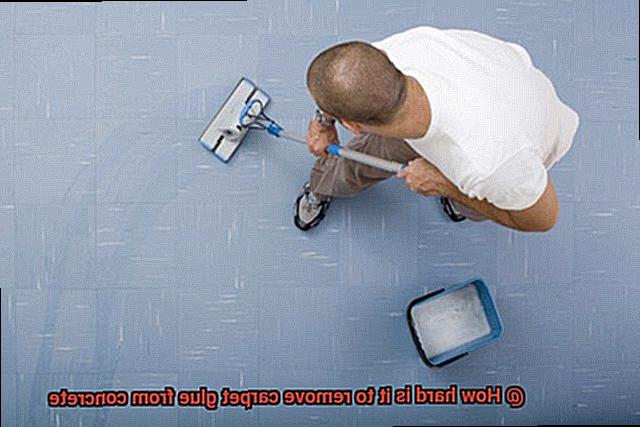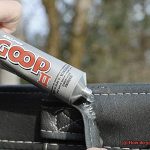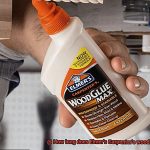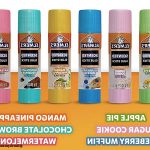Welcome to our blog post where we dive headfirst into the not-so-fun world of carpet glue removal from concrete floors.
So, you’ve made the bold decision to say goodbye to that tired old carpet and embrace the raw beauty of your concrete surface. Kudos to you.
But hold up, there’s one stubborn foe standing in your way: carpet glue. This sticky villain can turn a seemingly simple task into an all-out battle.
The burning question on your mind is, “Just how hard is it to remove carpet glue from concrete?” Well my friend, let me tell you, it’s no walk in the park.
Get ready as we explore a range of methods that will take you from mildly annoyed to full-on frustrated. But fear not.
Let’s get started, shall we?
Types of carpet glue and their adhesive properties
Contents
- 1 Types of carpet glue and their adhesive properties
- 2 Impact of age on carpet glue removal
- 3 Water resistance and its effect on removal methods
- 4 Assessing the condition of the concrete surface
- 5 Chemical solvents and adhesive removers for removal
- 6 Mechanical methods for removing carpet glue
- 7 Professional assistance and expertise in carpet glue removal
- 8 Tips and tricks for successful carpet glue removal
- 8.1 Step 1: Gather the necessary tools and supplies
- 8.2 Step 2: Scrape off as much of the carpet glue as possible
- 8.3 Step 3: Apply an adhesive remover or solvent
- 8.4 Step 4: Scrub away the loosened glue
- 8.5 Step 5: Repeat if necessary
- 8.6 Step 6: Use heat or natural alternatives (optional)
- 8.7 Step 7: Clean the concrete surface
- 9 Conclusion
Carpet glue is an essential component in ensuring that carpets stay firmly in place. However, when it comes to removing carpet glue from concrete surfaces, it can be a challenging and sticky task. In this article, we will explore the various types of carpet glue and their adhesive properties. Understanding these differences can help you choose the right type of glue for your needs and make the removal process more manageable.
Pressure-Sensitive Adhesive:
Pressure-sensitive adhesive is one of the most commonly used types of carpet glue. Its unique characteristic is that it remains tacky even after drying, allowing for easy repositioning of carpets. When it comes to removing pressure-sensitive adhesive from concrete, you’re in luck.
This type of glue can often be peeled away or scraped off with relative ease. By wearing gloves and using a putty knife or scraper, you can gently lift the glue off the surface without damaging the concrete.
Hot Melt Adhesive:
Hot melt adhesive is another popular type of carpet glue that is applied in a molten state and solidifies as it cools. This creates a strong bond between the carpet and the concrete surface. Unfortunately, removing hot melt adhesive can be more challenging.
To remove this type of glue from concrete, you may need to soften it with a heat gun or apply a specialized solvent to break down the bond before scraping it off.
Solvent-Based Glues:
Solvent-based carpet glues use chemical compounds to create a strong adhesive bond. These glues are often resistant to moisture and can withstand heavy foot traffic. However, removing solvent-based carpet glue from concrete can be tough.
To tackle this type of glue, you’ll need to use strong solvents or adhesive removers, taking safety precautions and ensuring proper ventilation. Patience and persistence are key when dealing with solvent-based carpet glue.
Water-Based Glues:
For those seeking an environmentally friendly option, water-based carpet glues are an excellent choice. These glues are easier to remove compared to solvent-based adhesives. You can often soften water-based glues with water or a mild detergent solution, making scraping or peeling them off the concrete surface a breeze.
However, it is important not to oversaturate the area, as excessive moisture can damage the concrete.
Age and Condition Matters:
It is essential to consider that the ease of removing carpet glue from concrete depends not only on the type of glue but also on factors such as its age, thickness, and the condition of the concrete surface. Older glues may harden over time and become more challenging to remove, while damaged or porous concrete surfaces could absorb more glue, making removal more difficult.
Conclusion:
Understanding the different types of carpet glue and their adhesive properties is crucial in choosing the right glue for your needs and effectively removing it from concrete surfaces.
Impact of age on carpet glue removal
Imagine the excitement of removing that worn-out carpet in your basement, only to be met with an unwelcome surprise – a stubborn layer of old carpet glue clinging to the concrete floor. Suddenly, your enthusiasm turns to frustration as you realize that this aged adhesive puts up a formidable fight.
What is it about older carpet glue that makes it so difficult to remove? Join us on a journey as we explore the impact of age on carpet glue removal and discover some invaluable tips and tricks along the way.
Weakened Adhesive Properties:
As time passes, the adhesive properties of carpet glue begin to deteriorate, resulting in a weakened bond. Just like attempting to peel off a sticker that has lost its stickiness, removing older carpet glue becomes an exasperating challenge.
Hardening Hazards:
Years of exposure to temperature fluctuations, moisture, and foot traffic cause older glues to harden and become more resistant to removal. It’s akin to scraping off dried-up gum from your shoe – a true sticky situation.
Changing Composition:
Surprisingly, the composition of carpet glue can vary between older and newer versions. Older glues may contain different ingredients or formulations, impacting their adhesive strength and resistance to removal. It’s like deciphering an ancient recipe – who knows what surprises await?
The Power of Bonding:
The bond between carpet glue and the concrete surface strengthens over time, making it even more challenging to remove. Breaking free from this super-strong handshake is undoubtedly a struggle.
Chemical Conundrum:
Chemical changes can occur in carpet glue over time, further complicating the removal process. These alterations may increase the resilience of the glue or modify its adhesive properties. It’s akin to solving a chemistry puzzle – predicting how the elements will react is an enigma.
Water resistance and its effect on removal methods
Imagine the frustration of trying to bid farewell to a worn-out carpet, only to discover stubborn remnants of water-resistant carpet glue clinging tenaciously to your concrete floor. Removing this adhesive can be a daunting task, but fear not. We’re here to shed light on the impact of water resistance and offer solutions to help you conquer this sticky situation with confidence and ease.
The Battle of Water Resistance:
Water resistance is a common property found in carpet glues, designed to withstand moisture and humidity for a secure bond between carpet and concrete. Unfortunately, this very property can make removal more challenging. Let’s dive into why water resistance poses a hurdle in the removal process and explore effective methods to overcome it.
Specialized Adhesive Removers:
Traditional water-based solvents or cleaners may struggle to penetrate and break down water-resistant carpet glue. However, the market offers specialized adhesive removers formulated specifically for tackling these stubborn glues.
These removers contain potent solvents or chemicals capable of effectively breaking down the adhesive, even in the face of water resistance. Remember to choose a remover suitable for your specific carpet glue’s level of water resistance.
Mechanical Methods:
Sometimes, brute force is necessary. When adhesive removers may not yield the desired results, mechanical methods such as scraping or sanding come to the rescue. While water resistance may pose challenges, applying physical force through scraping or sanding can gradually remove the glue from the concrete surface. Prioritize safety by wearing protective gear when employing these methods.
Understanding Water Resistance:

Not all carpet glues possess the same level of water resistance. The degree of resistance varies based on formulation and intended use. Before diving into the removal process, understanding your carpet glue’s water resistance level is crucial. This knowledge empowers you to choose the most appropriate removal method and avoid unnecessary frustration.
Assessing the condition of the concrete surface
Fear not. Before you embark on your adhesive removal journey, it is crucial to assess the condition of your concrete surface. By considering key factors such as surface texture, age and condition of the concrete, type of adhesive used, previous removal attempts, and environmental factors, you can achieve a successful and hassle-free removal process.
Surface Texture:
The texture of your concrete surface is a critical factor in determining how well the carpet glue adheres. Smooth surfaces offer less grip for the glue, making removal relatively easier. On the other hand, rough or porous surfaces can present a challenge as the glue tends to seep into crevices, making it harder to remove.
Age and Condition of Concrete:
The wear and tear on older concrete surfaces can impact adhesive adhesion. Cracks, chips, or uneven patches create additional spaces for the glue to bond tightly, complicating the removal process. Assessing any visible damage or deterioration will help you plan your removal strategy accordingly.
Type of Carpet Adhesive Used:
Different adhesives require different methods for effective removal. Water-based adhesives are generally easier to remove as they can be softened with water or an adhesive remover. Solvent-based adhesives may demand stronger solvents or mechanical methods. Knowing which type of adhesive was used will guide you in selecting the appropriate removal technique.
Previous Removal Attempts:
Evaluate any previous attempts at removing carpet glue from your concrete surface. Improper techniques or harsh chemicals may have caused damage or etching on the surface, making it more challenging to remove the remaining adhesive. Understanding any existing damage will help you avoid exacerbating the problem during the removal process.
Environmental Factors:
Consider the impact of environmental conditions on adhesive removal. Higher humidity levels make it difficult for removers to penetrate and soften the glue, while extreme temperatures affect their effectiveness. Assessing these factors will enable you to choose the optimal time and conditions for a successful removal.
Chemical solvents and adhesive removers for removal
We have the perfect solution in the form of chemical solvents and adhesive removers. Join me as we uncover the secrets of glue removal, armed with these magical solutions.
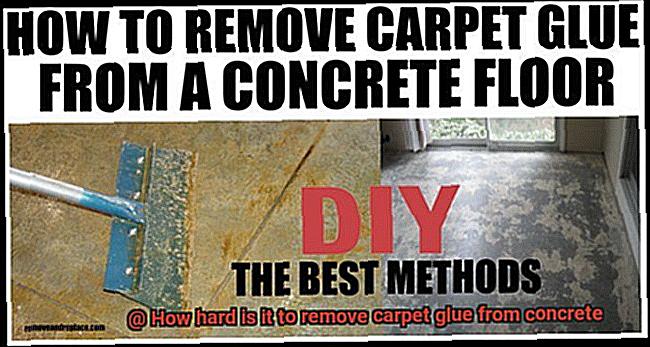
Types of Solvents:
Our first ally in this battle is the mighty acetone. Known for its adhesive-breaking prowess, this powerful solvent is readily available and budget-friendly. Acetone works wonders on various adhesives, including carpet glue. Just remember to don your protective gloves and work in a well-ventilated area to ensure safety.
The Process:
To begin, apply acetone directly onto the affected area. Allow it to sit for a few minutes, giving it time to penetrate the adhesive’s defenses. Armed with a trusty scraper or putty knife, gently lift off the softened glue from the concrete surface. Simple, right?
But wait, there’s more. Commercial adhesive removers take this game to the next level. Purposefully formulated to dissolve adhesives, they prove more effective than our versatile friend acetone.
Safety First:
When using adhesive removers, always adhere to the manufacturer’s instructions. Some may require dilution with water before application, while others can be used directly. Don’t forget those gloves and a well-ventilated workspace either. Safety should always be our top priority.
Persistence Pays Off:
Removing carpet glue isn’t always a walk in the park. Multiple applications may be necessary to achieve that clean concrete canvas you desire. So stay patient and persistent – Rome wasn’t built in a day, and neither was a glue-free floor.
A Word of Caution:
Certain types of carpet glue might be more resistant to chemical solvents or adhesive removers. In such cases, don’t despair. Additional methods like mechanical scraping or sanding can come to the rescue, ensuring a successful adhesive removal.
Cleanup Time:
After bidding farewell to the carpet glue, it’s time to clean up. Grab a bucket of water and mild detergent to wash away any residue left by the solvent or adhesive remover. Your concrete floor will thank you for it.
Mechanical methods for removing carpet glue
Bid farewell to that old carpet and embrace the allure of bare concrete floors. But wait, the resilient carpet glue stands defiantly, clinging to the surface like a determined warrior. Fear not, my friend. Allow me to guide you through the realm of mechanical methods for removing carpet glue from concrete. Prepare to unleash your inner warrior and conquer that adhesive beast.
Scraping: The Noble Art of Precision
On our battlefield, we wield the trusty putty knife, scraper, or floor scraper with grace and precision. Carefully scraping away the glue, we ensure not to harm the concrete beneath. Remember, a sharp blade and even pressure are essential to avoid gouges or scratches on your cherished flooring.
Grinding and Sanding: The Heavyweights
For larger areas or stubborn glue, it’s time to bring out the big guns – a grinder or sander with abrasive attachments. These mechanical warriors grind away the glue, revealing the raw beauty of your concrete floor. Beware the dust they may unleash; don protective gear and work in a well-ventilated space.
Heat: The Fiery Ally
In our quest for victory, we harness the power of heat. A heat gun or steam cleaner softens the adhesive, making it easier to scrape off. But tread cautiously, my friend, for excessive heat can damage the concrete surface. Wield this fiery ally with care.
The Chemical Arsenal: A Lethal Combination
Sometimes, brute force alone won’t suffice. Enter chemicals into our arsenal. Commercial adhesive removers or solvents loosen the glue before scraping or grinding. Yet remember, safety reigns supreme. Follow instructions and take precautions to safeguard yourself and the surroundings.
Preparation and Protection: The Key to Victory
Before charging into battle, ensure preparedness. Don your protective gear – gloves, goggles, and a mask – shielding yourself from injuries and exposure to dust or chemicals. Cover furniture or items that could suffer during the removal process. Trust me; it’s better to be safe than sorry.
Conclusion: A Glorious Triumph
Equipped with these mechanical methods, you stand poised to conquer the carpet glue that dares challenge you. Persistence is key, and multiple applications may prove necessary for ultimate victory. Test your chosen method in a small area, ensuring compatibility and avoiding potential damage.
Professional assistance and expertise in carpet glue removal
Carpet glue removal can be a daunting task, especially when it comes to concrete surfaces. But fear not. The solution lies in the hands of professionals who possess the specialized equipment, extensive knowledge, time-saving abilities, focus on safety protocols, and ability to achieve thorough results. Say goodbye to sticky situations and hello to a clean and glue-free surface with the help of professional carpet glue removal services.
Access to Specialized Equipment:
The pros have an arsenal of high-quality tools and products designed specifically for glue removal. These powerful weapons can break down the adhesive effectively without causing any damage to your precious concrete surface. From mighty grinders that pulverize stubborn stains to precision scrapers that delicately lift away residue, professionals are armed with the right equipment for any battle.
Knowledge of Various Techniques:
Removing carpet glue demands expertise in various techniques. Professionals possess extensive knowledge and experience in dealing with different types of carpet glue and concrete surfaces. They understand the complexities involved in this sticky situation and can tailor their approach accordingly. Whether it’s the strategic application of heat, the use of chemical solutions, or precise mechanical scraping, professionals can evaluate your concrete’s condition and determine the best method for optimal results.
Time and Effort Savings:
Let’s face it – removing carpet glue from concrete is a labor-intensive and time-consuming task. But fret not. By hiring professionals, you can save valuable time and effort. These seasoned experts have mastered efficient techniques that allow them to complete the job swiftly while you focus on other tasks or projects. So sit back, relax, and let the pros handle the hard work while you reap the rewards of a clean and glue-free surface.
Focus on Safety Protocols:
Some carpet glue removers contain harsh chemicals that can be hazardous if not handled properly. But fear not. Professionals are trained in proper safety protocols and take all necessary precautions to protect themselves and your property. By entrusting the job to professionals, you can have peace of mind knowing that safety is their top priority.
Achieving a Thorough and Satisfactory Result:
The ultimate goal of carpet glue removal is to unveil a clean, smooth surface ready for any new flooring installation. With their expertise, professionals can guarantee a thorough and satisfactory result. They have the skills to tackle even the most stubborn or old glue stains that may seem impossible to remove on your own. Say goodbye to unsightly residue and hello to a pristine concrete surface that will make your heart sing with joy.
Tips and tricks for successful carpet glue removal
Removing carpet glue from concrete can be a daunting task, but with the right tips and tricks, it can be done successfully. Whether you’re renovating your home or preparing to install new flooring, getting rid of stubborn carpet glue is a crucial step. In this article, we will provide you with a step-by-step guide on how to remove carpet glue effectively.
Step 1: Gather the necessary tools and supplies
Before starting the removal process, make sure you have the right tools on hand. You will need a scraper or putty knife, adhesive remover or solvent, a scrub brush, hot water, and a bucket. It’s also essential to wear protective gloves and goggles to ensure your safety.
Step 2: Scrape off as much of the carpet glue as possible
Begin by scraping off as much of the carpet glue as possible using a putty knife or scraper tool. Be careful not to damage the concrete surface while doing this. Start in one corner and work your way across the area, applying firm but gentle pressure to lift the glue.
Step 3: Apply an adhesive remover or solvent
Choose an adhesive remover or solvent that is safe for use on concrete surfaces. Look for products specifically designed for removing carpet glue. Apply it to a small area of the carpet glue and let it sit for a few minutes to allow for penetration. Follow the instructions provided by the manufacturer for best results.
Step 4: Scrub away the loosened glue
Once the adhesive remover has had time to work its magic, use a scrub brush or abrasive pad to scrub away the softened glue. Work in small sections at a time to ensure thorough removal. Apply moderate pressure while scrubbing to effectively break down and remove the glue.
Step 5: Repeat if necessary
For stubborn or older carpet glue, you may need to repeat the process multiple times or use a stronger adhesive remover. Be patient and persistent during this process. Apply the adhesive remover to the remaining glue, let it sit, and scrub again until all traces of glue are removed.
Step 6: Use heat or natural alternatives (optional)
If the adhesive remover doesn’t fully remove the carpet glue, you can try using a heat gun or a steamer to soften the glue. Apply heat directly to the glue until it becomes soft and pliable, then scrape it off with a putty knife or scraper tool. Alternatively, you can use natural alternatives like vinegar or lemon juice. Apply the solvent directly to the carpet glue and let it sit for some time before scrubbing it off.
Step 7: Clean the concrete surface
After removing the carpet glue, thoroughly clean the concrete surface with hot water and a mild detergent to remove any residue from the adhesive remover or solvent used. Use a scrub brush or mop to ensure all traces of glue and cleaning solution are removed.
z3MaDZAXA2o” >
Also Read: How To Remove Glue On Carpet?
Conclusion
Removing carpet glue from concrete can be a daunting task. It requires time, effort, and patience to achieve satisfactory results. The level of difficulty largely depends on the type and age of the glue, as well as the condition of the concrete surface.
But fear not, for with the right tools and techniques, this stubborn adhesive can be conquered. It may take some elbow grease and perseverance, but the end result will be worth it.
One method to tackle carpet glue is by using a chemical adhesive remover. These powerful solutions are designed to break down and dissolve the glue, making it easier to remove. However, caution must be exercised when working with these chemicals, as they can be harmful if not handled properly.
Another approach is mechanical removal, which involves scraping or grinding away the glue using specialized tools such as scrapers or floor grinders. This method requires physical strength and precision to avoid damaging the concrete surface.
Regardless of the method chosen, it’s important to note that removing carpet glue from concrete is a time-consuming process. It may require multiple attempts and thorough cleaning afterwards to ensure all traces of adhesive are eliminated.
In conclusion, while removing carpet glue from concrete may pose a challenge, it is not an impossible task. With determination and proper techniques, you can restore your concrete surface to its former glory.

